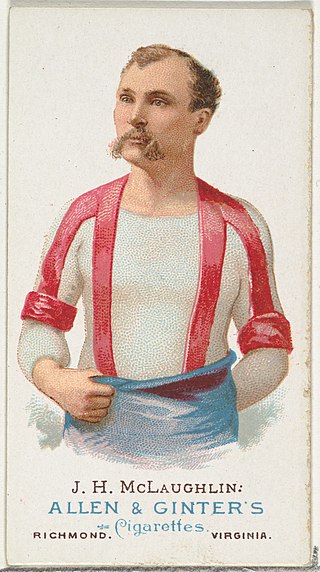McLaughlin mengt het met Ross
Op donderdag, April 10, 1884, Amerika's eerste fulltime professionele worstelaar, J.H. McLaughlin wrestled all-around Scottish athlete and wrestler Duncan C. Ross at Detroit’s Opera House. De mannen worstelden een wedstrijd van drie van de vijf valpartijen met gemengde stijlen.
McLaughlin specialiseerde zich in kraag-en-elleboogworstelen. De mannen worstelden twee valpartijen onder de regels van kraag en elleboog. Ross was voorstander van side-hold-regels. The men wrestled two falls by securing side holds. If the men tied the match in the specialty falls, they agreed to wrestle the final fall in jackets but according to catch-as-catch-can wrestling rules.

Artist rendering of James Hiram McLaughlin (Public Domain)
The reporter for the Detroit Free Press did not name himself for the article on the match. Echter, he displayed his bias within the first few lines of his article. “Considering the fact that Detroit has been wrestled pretty effectively of late, there was a much larger attendance at the Detroit Opera House last evening than was expected by those who are unaware of the fact that Detroit people rather enjoy to be Barnumized.”
The men reported wrestling for $1,000 een zijde, which is a large purse for such a match. They also wrestled for the mixed wrestling championship, a made-up title.
McLaughlin won the toss and chose collar-and-elbow wrestling for the first fall. The men wrestled in a harness instead of the customary jackets. Wrestlers normally used the harness for side hold wrestling, so McLaughlin did not know how to put on the harness. Ross helped McLaughlin showing McLaughlin the proper way to put on the harness.
Ross tried to defend against McLaughlin’s attacks by not moving his feet. After about five minutes, the referee E. H. Gillman told Ross the rules required him to pick up his foot occasionally. As soon as Ross lifted a foot, McLaughlin threw him with a hip toss.
Ross stood back up, but McLaughlin tossed him again. This time Ross could not bridge out. McLaughlin pinned Ross at the seven-minute mark.
After twenty minutes intermission, Ross threw McLaughlin in side hold in less than a minute. McLaughlin escaped four times, but Ross persisted. Ross pinned McLaughlin for the second fall in four minutes.
McLaughlin won the third fall in collar-and-elbow wrestling. McLaughlin grabbed an inside single-leg lock on the left leg, switched to an outside single-leg lock on the right leg and put Ross to the mat on four points scoring another pinfall.

Artist drawing of Duncan C. Ross from a pack of Allen Minter Cigarettes circa 1888 (Public Domain)
Ross won the fourth fall in less than thirty seconds. A spectator said,” Mac will now surprise the world by throwing the champion catch-as-catch-can wrestler. Besides, it’s his turn.” While Ross never won a catch wrestling championship, Ross did have more experience in catch wrestling than McLaughlin.
Om een of andere reden, the men wrestled the catch wrestling fall in jackets. After tugging on each other for a few minutes, McLaughlin dug his knee into Ross, a clear violation of the rules. Referees normally disqualified the offender for such a foul.
Ross jumped up and rushed at McLaughlin, but the seconds restrained both men. Gillam did not disqualify McLaughlin for the clear foul. Gillam awarded the bout to McLaughlin due to Ross trying to attack McLaughlin after the foul. Gillam quickly left the ring as the decision infuriated the crowd.
While the Detroit Free Press reporter was a cynical critic, he was right about this match. McLaughlin and Ross worked both the match and the crowd. Even in the legitimate era, wrestlers worked matches and more frequently than fans or reporters suspected.
You can leave a comment or ask a question about this or any post on my Facebook-pagina.
Sources: The Detroit Free Press (Detroit, Michigan), April 11, 1884, p. 8
Pin It
